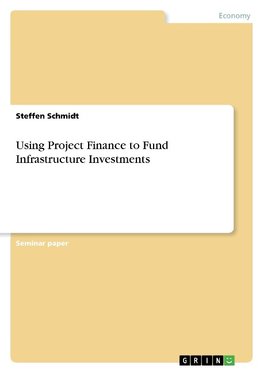
-
 Anglický jazyk
Anglický jazyk
Using Project Finance to Fund Infrastructure Investments
Autor: Steffen Schmidt
Seminar paper from the year 2015 in the subject Economics - Finance, grade: 1,3, , language: English, abstract: The competitiveness and the ability of economic growth and the local living standards are closely related to a country's infrastructure quality... Viac o knihe
Na objednávku
16.65 €
bežná cena: 18.50 €
O knihe
Seminar paper from the year 2015 in the subject Economics - Finance, grade: 1,3, , language: English, abstract: The competitiveness and the ability of economic growth and the local living standards are closely related to a country's infrastructure quality and volume. After World War II, in Europe huge investments in infrastructure, such as roads, railways or hospitals were traditionally financed by public sources, such as tax revenues, over-printing of money or borrowings. Today, especially in the developing countries there is a huge demand for infrastructure investments.
There exist so-called "infrastructure gaps": In order to improve the standard of living and the attractiveness of a country and econ-omy, the segments of transport, electricity generation, transmission as well as water and telecommunications are essential. The main problem for governments is that Infrastructure projects within these segments usually have a huge extent and require a lot of capital, which often is not available. The OECD estimates that there exists a global infrastructure investment requirement of 71 trillion dollars by the year 2030 only to improve the basic infrastructure. But also in Europe there is an important demand for infrastructure investments. Today, post financial crisis, the TEN-T pro-gram which started in 2014 and also the energy distribution networks or the power plants will require very huge amounts of capital in the coming years and decades, while the political and economic situation is rather uncertain.
The forms of financing projects like the above mentioned have changed substantially: Over the past years and decades, severe budget constraints and inefficient manage-ment of infrastructure projects by public entities have led to an increased involvement of private investors in the business of infrastructure financing. This development has attached more and more importance to concrete strategies of private financing forms or partnerships. In recent years this private funding has increasingly taken the form of project finance. So there are basically the following questions: What exactly is project finance, how can a partnership between a public and a private entity be es-tablished and how can this construct help to solve the problem of the mentioned infrastructure gap? The scope of project finance, the different forms and the critical success factors and the meaning for infrastructure finance are the subject of this assignment.
- Vydavateľstvo: GRIN Verlag
- Rok vydania: 2016
- Formát: Paperback
- Rozmer: 210 x 148 mm
- Jazyk: Anglický jazyk
- ISBN: 9783668281103












